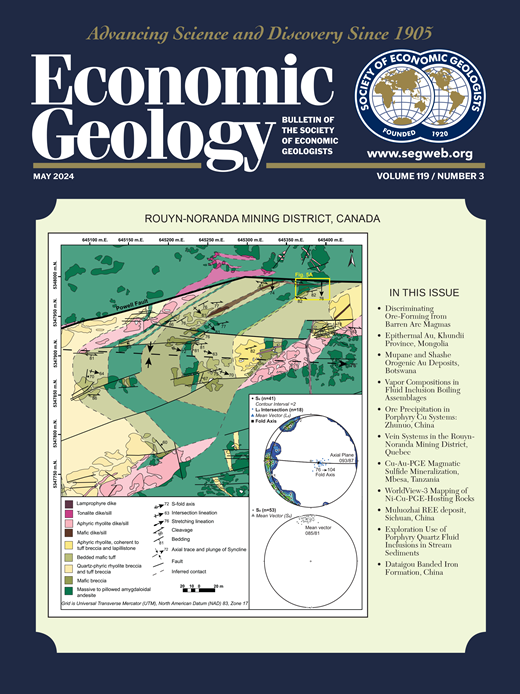Are Alkalic Porphyry Deposits Overlain by Advanced Argillic Lithocaps?
IF 4.9
1区 地球科学
Q1 GEOCHEMISTRY & GEOPHYSICS
引用次数: 0
Abstract
A commonly highlighted feature that distinguishes alkalic porphyry deposits from those associated with calc-alkaline magmatism is a paucity of the advanced argillic alteration that can form shallow-level lithocaps. This scarcity has been attributed to either the inability of alkalic systems to generate the necessary hyperacidic fluids or erosional removal. Here, it is concluded that erosional removal is responsible, as supported by the following four lines of evidence: Alkaline stratovolcanoes at convergent margins emit as much SO2—the principal ingredient for hyperacidic fluid formation—as those in calc-alkaline arcs;At least one example of recently formed lithocap alteration in an alkaline volcano (Vulcano, Italy) is known;Remnants of advanced argillic lithocaps are present in several alkalic porphyry systems, but only those of Cenozoic age, whereas Paleozoic and Mesozoic deposits, including those in the Macquarie arc of New South Wales, Australia, and the Intermontane belt of British Columbia, Canada, appear to lack them; andAvailable fluid inclusion pressure estimates for alkalic porphyry deposits show paleodepths of at least 1.5 km, possibly up to several km, for deposits lacking lithocaps, consistent with their erosional removal. Therefore, it is concluded that preservation potential, influenced to a significant degree by formational age, is a fundamental control on the presence or absence of lithocaps above alkalic porphyry deposits—as, of course, it is in porphyry systems hosted by calc-alkaline intrusions. Thus, the presence of lithocaps in association with both alkaline and calc-alkaline igneous centers is evidence for concealed shallow intrusions and potential porphyry-type mineralization.碱性斑岩矿床上覆有先进的泥质岩性盖层吗?
区分碱性斑岩矿床与钙碱性岩浆作用相关的斑岩矿床的一个普遍突出的特征是缺乏可以形成浅层岩盖的高级泥质蚀变。这种稀缺性要么是由于碱性系统无法产生必要的高酸性流体,要么是由于侵蚀作用。在这里,我们得出结论,侵蚀作用是主要原因,这得到了以下四方面证据的支持:收敛边缘的碱性层状火山释放的二氧化硫(高酸性流体形成的主要成分)与钙碱性弧中的火山一样多;在碱性火山(意大利Vulcano)中至少有一个最近形成的岩盖蚀变的例子;在一些碱性斑岩体系中也有先进泥质岩盖的残余,但只存在于新生代,而古生代和中生代矿床,包括澳大利亚新南威尔士州麦夸里弧和加拿大不列颠哥伦比亚省的山间带,似乎缺乏这种残余;碱性斑岩矿床的现有流体包裹体压力估计表明,缺乏岩盖的矿床的古深度至少为1.5公里,可能高达几公里,这与它们的侵蚀作用相一致。因此,我们得出结论,在很大程度上受地层年龄影响的保存潜力,是决定碱性斑岩矿床上是否存在岩性盖层的基本控制因素——当然,在钙碱性侵入体为主的斑岩系统中也是如此。因此,与碱性和钙碱性火成岩中心相关的岩盖的存在是隐伏浅层侵入和潜在斑岩型成矿的证据。
本文章由计算机程序翻译,如有差异,请以英文原文为准。
求助全文
约1分钟内获得全文
求助全文
来源期刊

Economic Geology
地学-地球化学与地球物理
CiteScore
10.00
自引率
6.90%
发文量
120
审稿时长
6 months
期刊介绍:
The journal, now published semi-quarterly, was first published in 1905 by the Economic Geology Publishing Company (PUBCO), a not-for-profit company established for the purpose of publishing a periodical devoted to economic geology. On the founding of SEG in 1920, a cooperative arrangement between PUBCO and SEG made the journal the official organ of the Society, and PUBCO agreed to carry the Society''s name on the front cover under the heading "Bulletin of the Society of Economic Geologists". PUBCO and SEG continued to operate as cooperating but separate entities until 2001, when the Board of Directors of PUBCO and the Council of SEG, by unanimous consent, approved a formal agreement of merger. The former activities of the PUBCO Board of Directors are now carried out by a Publications Board, a new self-governing unit within SEG.
 求助内容:
求助内容: 应助结果提醒方式:
应助结果提醒方式:


